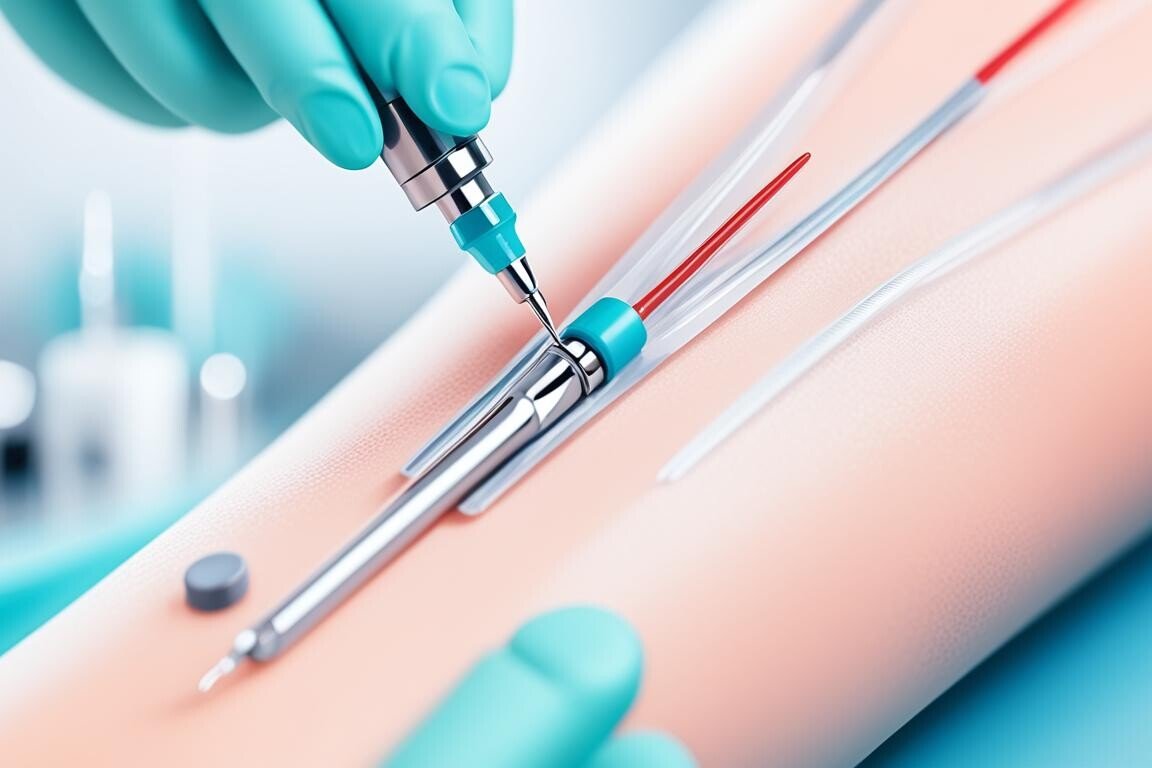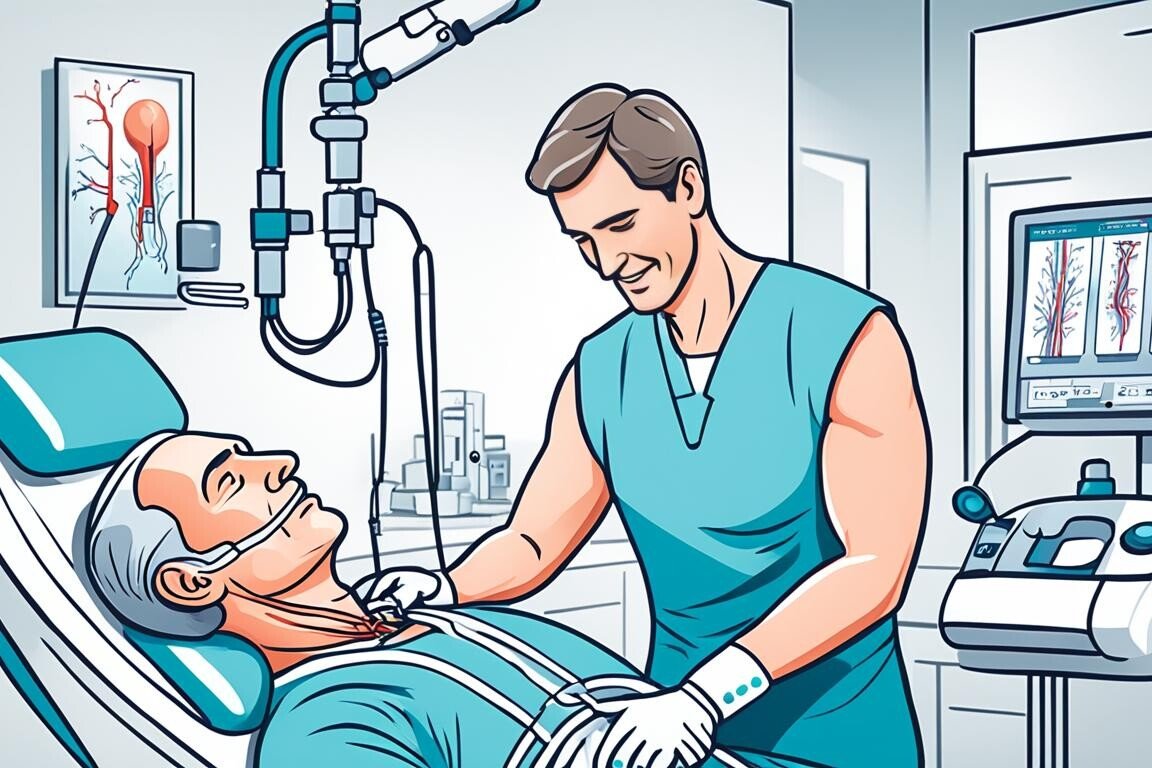Finding the right treatment for back pain is key to feeling better and living better. Whether it’s chronic pain, a new injury, or an underlying issue, there are many ways to help in your area. This guide will walk you through the options, from over-the-counter meds and physical therapy to surgery as a last choice.
Working with your healthcare provider, you can create a plan that suits you. This plan will help manage your symptoms and improve your mobility. It covers everything from back pain management near me to advanced spinal decompression therapy and herniated disc treatment.
If you’re facing lower back pain treatment or need help from a spine specialist, this guide is for you. It aims to help you make smart choices and find non-surgical back pain solutions and sciatica pain management. Look into the many options available to you and start on the path to better health.
Table of Contents
ToggleImportance of Proper Sleep Positioning for Back Pain Relief
Getting good sleep is key to handling back pain. Poor sleep positions can make back pain worse. To keep your spine in line and ease back strain, try sleeping on your side with a pillow between your knees. If you must sleep on your back, put a pillow under your knees. A comfy, supportive mattress and pillow can greatly improve your sleep and reduce pain.
Techniques for Maintaining Spinal Alignment While Sleeping
To keep your spine aligned and ease back pain at night, follow these tips:
- Sleep on your side with a pillow between your knees to keep your spine’s natural curve.
- If you like sleeping on your back, use a pillow under your knees for lower back support.
- Avoid stomach sleeping as it can twist your spine and cause neck and back pain.
- Choose a medium-firm mattress and a supportive pillow for proper spinal alignment all night.

Using these sleep tips and picking the right mattress and pillows can help ease back pain and better your sleep quality. Good sleep is vital for your health and well-being. These simple changes can significantly help in managing your back pain.
Correcting Posture to Alleviate Back Pain
Good posture is key to managing and preventing back pain. It matters whether you’re sitting or standing. Poor posture can make back pain worse by putting strain on your spine. By adjusting your posture, you can ease back pain and support your spine.
When sitting, keep your shoulders relaxed and your back supported. Don’t slouch or lean forward, as this can hurt your lower back. Instead, sit upright with your feet on the floor and knees at a 90-degree angle. Also, make sure your workstation is set up to help you sit better.
Standing right is also crucial for back pain relief. Keep your head up, shoulders back, and core tight. Don’t lock your knees, as this can hurt your lower back. If you stand a lot, take breaks to stretch and move around to avoid stiffness and pain.

Using these posture tips every day can help reduce back pain and stop future problems. Being aware of your posture lets you support your back and keep your spine healthy.
Over-the-Counter Pain Medication Options
OTC pain relievers can help with back pain. NSAIDs and acetaminophen are two common choices. NSAIDs like ibuprofen and naproxen reduce inflammation. Acetaminophen targets pain signals.
Understanding Nonsteroidal Anti-Inflammatory Drugs (NSAIDs) and Acetaminophen
NSAIDs can ease back pain but be careful with dosage. Taking too much or using them for a long time can cause stomach issues, bleeding, and harm to kidneys or liver. Acetaminophen is safer and often the first choice for treating pain.
Always talk to your healthcare provider before taking over-the-counter pain meds. This is especially true if you have other health issues or take other drugs. They can help you use these medications safely and effectively for your back pain.

- Acetaminophen is often recommended as a first-line treatment for back pain due to its lower risk of side effects.
- NSAIDs like ibuprofen and naproxen can be effective in reducing inflammation, but they carry a higher risk of side effects with prolonged use.
- It’s crucial to follow dosage instructions and consult with a healthcare provider before using over-the-counter pain relievers, especially if you have any underlying medical conditions.
Prescription Medications for Chronic Back Pain
If you have chronic or severe back pain that over-the-counter options don’t help, you might need prescription drugs. These include stronger NSAIDs, opioid painkillers, and muscle relaxants. But, it’s important to use these drugs carefully and with a doctor’s watchful eye. This is because they can have side effects and may lead to dependence, especially with opioids.
Your doctor will help find the right mix of prescription drugs for you. They might start with stronger NSAIDs like meloxicam or naproxen to see if they work better than what you can buy over the counter. If needed, they might add an opioid like hydrocodone or oxycodone for short-term use during flare-ups.
They might also prescribe muscle relaxants, such as cyclobenzaprine or tizanidine, to ease muscle spasms and tension. But remember, these drugs can make you feel sleepy and dizzy. So, be careful if you’re driving or using heavy machinery.
Your doctor will create a pain management plan that considers the pros and cons of prescription drugs for your back pain. They’ll keep an eye on how you’re doing and change your treatment as needed. This way, you get the best and safest care possible.

Antidepressants for Chronic Back Pain Management
If you’re dealing with ongoing back pain, you might find relief in antidepressants. These drugs are mainly for depression and anxiety but can also help with chronic back pain. This is true even if you’re not feeling depressed.
Antidepressants work by changing chemicals in the brain that affect pain. Your doctor might suggest one as part of your plan to manage back pain.
Tricyclic antidepressants like amitriptyline, nortriptyline, and doxepin are often used for pain. They can help with different kinds of chronic pain, including back pain and nerve pain. But, they might cause side effects like blurry vision, feeling sleepy, dry mouth, and trouble peeing.
Other antidepressants, such as SNRIs and SSRIs, can also ease chronic pain. SNRIs like duloxetine and venlafaxine are good for both depression and pain. SSRIs like paroxetine and fluoxetine can make tricyclic antidepressants work better for pain.
Remember, antidepressants can be a key part of managing pain, but they carry a risk of suicidal thoughts or actions. If you notice any changes in your mood, talk to your healthcare provider right away.

Physical Therapy for Strengthening Core Muscles
If you’re dealing with back pain, physical therapy can really help. Experts in physical therapy create special exercise plans for your core muscles. These muscles support your spine. By making them stronger, you can ease your back pain now and avoid it later.
Importance of a Strong Core for Back Pain Prevention
A strong core is key to keeping your spine safe and healthy over time. Your core includes muscles like your abs, back, and hip flexors. They work together to support your spine. If they’re weak or not balanced, you might have poor posture, muscle strain, and more back pain.
Regular physical therapy can boost your core strength, flexibility, and endurance. This can lessen your back pain now and lower your risk of future problems. Your therapist might use exercises like planks, crunches, and Pilates moves to meet your body’s needs.
Physical therapy also includes heat and ice therapy, manual massage, and postural training. These help you get lasting relief. With a skilled therapist’s help, you can manage your back pain and better your spinal health.

Choosing physical therapy is a smart move for your back health. With a tailored plan and expert support, you can use your core muscles to live a pain-free, active life.
Benefits of Exercise for Quick Back Pain Relief
If you’re dealing with back pain, staying active can help. Doctors now say to avoid too much rest, as it can make things worse. Instead, try easy activities like walking, swimming, or yoga. These keep your body moving and help blood flow to sore spots.
Studies from 2019 show that exercise can make your posture better and ease back pain. Regular activities like walking or swimming boost your physical function and mental health. Plus, using menthol on your skin can numb pain receptors, offering quick relief for back pain.
- Exercises like knee to chest stretch, lower back rotational stretch, and glute bridges can ease lower back pain. Do these exercises 2 to 3 times a day, starting with 5 to 30 reps to see better results.
- These exercises can be repeated 2 to 3 times daily for optimum benefits, gradually building up repetitions from 5 to 30 to enhance their effectiveness.
Regular exercise and muscle strengthening can help with back pain. By doing low-impact activities, you can find quick relief and boost your health.

Hot and Cold Therapy for Back Pain
Dealing with back pain can be tough. But, using hot and cold therapy can help a lot. Whether it’s a sudden pain or ongoing discomfort, ice packs and heating pads can really help.
Proper Application Techniques for Ice and Heat Packs
Start by putting an ice pack on the painful spot for 10-15 minutes, several times a day. This cold therapy reduces swelling and eases the pain. Later, switch to a heating pad or warm compress to relax muscles and boost blood flow, aiding healing.
Always cover hot or cold packs with a thin towel to protect your skin from burns or frostbite. Getting the timing and method right is key to making this therapy work best.
Heat therapy can cut down stiffness and tension, and its effects last up to 48 hours. You can wear heat wraps for up to 8 hours for ongoing relief. Cold therapy, however, reduces swelling and pain by slowing blood flow to the area.
If hot or cold therapy doesn’t help your pain after regular use, or if you have skin issues, see your doctor. They can suggest other treatments.
Massage Therapy and Spinal Manipulation
For those struggling with back pain, massage therapy and spinal manipulation can offer relief. Massage relaxes tense muscles. Spinal manipulation helps restore mobility and fix spine issues by a licensed chiropractor or other expert.
Studies show that hands-on treatments for back pain work well, especially for long-term pain. But, the relief may lessen if you stop getting treatments. You might need regular sessions to keep feeling good.
Chiropractic care is another good choice for spinal manipulation for back pain. Chiropractors use techniques like spinal adjustments and soft tissue therapy. These methods aim to fix back pain’s root causes and boost spinal health.
Choosing massage therapy or chiropractic care can be a natural way to ease back pain and better your life. Always talk to a healthcare expert to find the best treatment for you.
Nerve Stimulation Techniques for Chronic Back Pain
If you’re dealing with chronic back pain, you might look into nerve stimulation as an alternative. Techniques like acupuncture and transcutaneous electrical nerve stimulation (TENS) are being studied for their potential in easing this pain.
Acupuncture uses thin needles at certain body points to block pain signals. While its effects on back pain vary, it might help some people who haven’t found relief with other treatments.
TENS works by sending mild electrical pulses to block pain signals to the brain. Like acupuncture, its effectiveness for back pain is not clear-cut. Yet, it could be an option for those who haven’t found relief with other treatments.
Considering nerve stimulation methods like acupuncture and TENS could be beneficial for managing back pain. Always talk to your healthcare provider to see if these options are right for you.
Cognitive Behavioral Therapy for Back Pain Management
Dealing with the mental side of back pain is as crucial as the physical treatments. Cognitive Behavioral Therapy (CBT) is a top choice for those with chronic back pain. It helps you learn new ways to handle pain, like changing negative thoughts and actions. By focusing on the mind and feelings, CBT can greatly reduce pain and improve daily life.
CBT usually takes 10 to 20 sessions with a therapist. You’ll learn to spot and fix thoughts that make your pain worse. Adding regular, easy exercises like walking or swimming can also help prevent back pain. For CBT to work best, set clear goals and take things one step at a time.
Thinking positively can lessen pain by making you feel better. This means having good thoughts and using methods like yoga, massage, or imagery to calm your mind and body. Switching negative thoughts to positive ones can help you handle pain better.
Studies show CBT is great for chronic lower back pain. 78% of people found it helped them get back to work. Those who haven’t found relief with meds or physical therapy might find this approach very helpful.
CBT is often used with other treatments like meds, physical therapy, or surgery. It has fewer risks and side effects. For CBT to work, you need to actively take part, finish the program, and be open to new skills. It can improve how you cope with pain and enhance your life quality.
Biofeedback: A Drug-Free Approach to Pain Control
If you’re looking for a biofeedback for back pain, a non-drug pain management technique, or a mind-body approach to back pain, consider biofeedback therapy. This method lets people take charge of their pain by learning to control their body’s responses.
Biofeedback uses special equipment to track and give real-time feedback on things like breathing, heart rate, muscle tension, and skin temperature. By controlling these, people can lessen their back pain without using drugs.
Research shows biofeedback can be better than usual pain relief methods, reducing back pain by 30% in some cases. It’s also safe and doesn’t have the side effects some drugs do.
Biofeedback therapy includes several sessions where you learn to manage your body’s responses. This approach focuses on the mind and body to help with non-drug pain management techniques. It’s great for those wanting a complete solution to their back pain.
Looking into biofeedback for back pain? Make sure to find certified practitioners and licensed professionals for quality care. With the right help, biofeedback can be a key part of managing and easing your back pain.
Spinal Injections for Targeted Pain Relief
If your back pain doesn’t get better with regular treatments, your doctor might suggest spinal injections. These injections use corticosteroids to lessen inflammation or anesthetics to block pain. They aim to ease your pain directly.
Spinal injections can help with back pain, but they’re not forever fixes. Your doctor will watch how many you get each year to prevent side effects. These can include mild soreness or pain where you got the shot, and in rare cases, bleeding or infection.
Conditions like herniated or bulging discs, spinal stenosis, failed back surgery syndrome, and other spinal injuries might benefit from spinal injections. Epidural steroid injections can ease pain for a while or even a long time. They might also help figure out what’s causing your pain.
Your doctor might also think about nerve blocks with medicines like Lidocaine. These can make you feel almost pain-free for a few hours. Facet joint blocks and facet neurotomy are other minimally invasive back pain treatments. They can help for weeks or months.
Remember, spinal injections aren’t a magic fix. Your doctor will help create a full treatment plan. This might include different therapies to manage your back pain well.
Back pain management near me
If you’re dealing with ongoing back pain, finding the right local options can really help. Start by talking to your primary care doctor. They can suggest good back pain specialists, physical therapists, or pain clinics near you. You can also look up online directories and review sites to find top-rated providers in your area and check out what patients say.
When looking for back pain management clinics near me, think about the doctor’s qualifications, the treatments they offer, and insurance or financing options. This will help you find a good match for your needs and budget.
Your healthcare provider might suggest a mix of treatments for your back pain, such as:
- Physical therapy to strengthen core muscles and improve flexibility
- Spinal injections or nerve stimulation techniques for targeted pain relief
- Cognitive behavioral therapy or biofeedback to address the mental and emotional aspects of pain management
- Medications, both over-the-counter and prescription, to alleviate symptoms
If non-surgical treatments don’t work well, your spine specialists may talk about surgery as a last choice. But, it’s important to try all non-surgical options first.
By doing your homework and finding the best local treatment options, you’re taking a big step towards better back pain management. This can greatly improve your life quality.
Surgical Options as a Last Resort
When non-surgical treatments for chronic back pain don’t work, surgery might be the last choice. Procedures like spinal decompression surgery or spinal fusion procedures aim to fix specific spine problems. But, it’s key to know the risks and benefits of back surgery.
Understanding the Risks and Benefits of Back Surgery
Back surgery can help with certain chronic pain causes like herniated disks or bone spurs. But, it also has risks. These include infection, nerve damage, and not fully relieving pain. Also, surgery might not fix the main cause of back pain.
Before surgery, talk deeply with your spine specialist. They can explain the good and bad of the surgery. A detailed check-up and a plan made just for you are key. This ensures surgery is right for your condition and needs.
Remember, surgery should be a last choice. Most back pain can be handled with non-surgical treatments. By trying all options and working with your healthcare team, you can make a choice that fits your goals and needs for managing your back pain.
Conclusion
Back pain can be tough, but there are many ways to get relief. Working with your healthcare provider helps you find the right mix of treatments. This includes medicines, physical therapy, and changes in your lifestyle.
Everyone is different, so what works for one person might not work for another. Be open to trying different things until you find what works best for you. With the right care, you can manage your back pain and live a better life.
If you’re dealing with back pain, this article has given you a good overview of your options. You can talk to your doctor about non-surgical and surgical treatments. Together, you can create a plan that helps you feel better and move freely again.
FAQ
What are the most effective back pain management options in my local area?
How can proper sleep positioning help alleviate my back pain?
How can I correct my posture to help relieve my back pain?
What over-the-counter pain medications can I use to manage my back pain?
When would I need to use prescription medications for my chronic back pain?
Can antidepressants be used to manage chronic back pain?
How can physical therapy help with my back pain?
How can exercise help provide quick relief for my back pain?
How can hot and cold therapy help manage my back pain?
What types of hands-on treatments can provide relief for my back pain?
Can nerve stimulation techniques like acupuncture and TENS help with my chronic back pain?
How can cognitive behavioral therapy (CBT) help with back pain management?
How can biofeedback help with my chronic back pain?
When would a doctor recommend spinal injections for my back pain?
What are the surgical options for chronic back pain that has not responded to other treatments?
Source Links
About The Author

This article is medically reviewed by Dr. Chandril Chugh, Board-Certified Neurologist, providing expert insights and reliable health information.
Dr. Chandril Chugh is a U.S.-trained neurologist with over a decade of experience. Known for his compassionate care, he specializes in treating neurological conditions such as migraines, epilepsy, and Parkinson’s disease. Dr. Chugh is highly regarded for his patient-centered approach and dedication to providing personalized care.
→ Book a consultation to discover which remedies suit your needs best.




